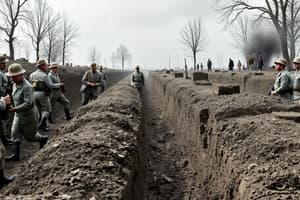Podcast
Questions and Answers
What term is now commonly used to refer to the mental strain experienced by soldiers during warfare?
What term is now commonly used to refer to the mental strain experienced by soldiers during warfare?
- Shell shock
- Combat anxiety
- Post-Traumatic Stress Disorder (correct)
- Battle fatigue
Which advancement in technology contributed to making warfare more deadly during the Industrial Revolution?
Which advancement in technology contributed to making warfare more deadly during the Industrial Revolution?
- Bow and arrow
- Infantry formations
- Horse-drawn carriages
- Advanced artillery and machine guns (correct)
What were some common reasons why men enlisted to go to war?
What were some common reasons why men enlisted to go to war?
- Personal vendettas and conflicts with neighbors
- Patriotism, nationalistic pride, and societal pressure (correct)
- Desire for financial security and household stability
- Attraction to military uniforms and status
How did recruitment posters during World War I primarily influence potential soldiers?
How did recruitment posters during World War I primarily influence potential soldiers?
What type of conditions did soldiers endure during their service, apart from combat?
What type of conditions did soldiers endure during their service, apart from combat?
What was a primary long-term cause of World War I?
What was a primary long-term cause of World War I?
How did Australia initially end up in World War I?
How did Australia initially end up in World War I?
Which of the following best describes trench warfare during World War I?
Which of the following best describes trench warfare during World War I?
What was a significant outcome of the Gallipoli campaign?
What was a significant outcome of the Gallipoli campaign?
What was a common condition faced by soldiers in the trenches during World War I?
What was a common condition faced by soldiers in the trenches during World War I?
Which technology was NOT commonly used in World War I warfare?
Which technology was NOT commonly used in World War I warfare?
What characterized the nature of warfare in World War I?
What characterized the nature of warfare in World War I?
Why did the Allies face heavy casualties at Gallipoli?
Why did the Allies face heavy casualties at Gallipoli?
Flashcards
World War 1 short-term causes
World War 1 short-term causes
The assassination of Archduke Franz Ferdinand and rising tensions between European powers.
World War 1 long-term causes
World War 1 long-term causes
Militarism, alliances, imperialism, and nationalism.
Australia's response to WWI
Australia's response to WWI
Australia declared support for Britain, automatically entering the war in 1914.
Trench warfare
Trench warfare
Signup and view all the flashcards
Modern warfare in WWI
Modern warfare in WWI
Signup and view all the flashcards
Gallipoli Campaign
Gallipoli Campaign
Signup and view all the flashcards
Trench Conditions
Trench Conditions
Signup and view all the flashcards
Australian Imperial Force (AIF)
Australian Imperial Force (AIF)
Signup and view all the flashcards
Shell shock
Shell shock
Signup and view all the flashcards
Camaraderie in WWI
Camaraderie in WWI
Signup and view all the flashcards
How did the Industrial Revolution change warfare?
How did the Industrial Revolution change warfare?
Signup and view all the flashcards
Reasons for enlisting in WWI
Reasons for enlisting in WWI
Signup and view all the flashcards
Recruitment posters in WWI
Recruitment posters in WWI
Signup and view all the flashcards
Study Notes
Short-Term and Long-Term Causes of World War I
- Short-term causes: Assassination of Archduke Franz Ferdinand, rising tensions between European powers.
- Long-term causes: Militarism, alliances, imperialism, and nationalism, European competition for power, resources, and influence.
Australia's Response to World War I
- Declared support for Britain, automatically entered the war in 1914.
- Thousands of volunteers joined the Australian Imperial Force (AIF).
- Significant contributions to major campaigns (e.g., Gallipoli, Western Front).
- Shaped Australian national identity.
Nature of Warfare in WWI
- Shift to modern, industrialized warfare.
- Characterized by trench warfare.
- Soldiers fought from entrenched positions.
- Stalemate resulted.
- New technologies (machine guns, tanks, airplanes, poison gas) caused devastating casualties.
- Predominantly defensive warfare with limited territorial gains.
Trench Warfare
- Soldiers fought from fortified ditches (trenches) for protection.
- Trenches stretched across battlefields.
- Long periods of stalemate.
- Soldiers faced harsh conditions: mud, rats, disease, constant threat of attacks.
- Goal: gain small strategic territories.
- High casualties and prolonged suffering.
Gallipoli Campaign
- Allied forces (including Australia and New Zealand) tried to capture the Dardanelles Strait.
- Objective: weaken the Ottoman Empire.
- Faced strong Turkish resistance.
- Heavy Allied casualties.
- Withdrawal without achieving objectives.
- Became a symbol of bravery and sacrifice for Australia and New Zealand, shaping their national identities.
Life in the Trenches
- Harsh and uncomfortable.
- Constant threats of enemy fire, artillery bombardment, snipers.
- Overcrowded, muddy trenches.
- Pests (rats, lice), diseases (dysentery).
- Unsanitary conditions.
- Limited food, extreme weather.
- Long periods of boredom, punctuated by violent combat.
- Mental strain ("shell shock," now PTSD) was widespread.
- Strong bonds of camaraderie.
- Remarkable resilience.
Industrial Revolution's Impact on Warfare
- Advanced weaponry (machine guns, artillery).
- New technologies (tanks, airplanes).
- Mass production of weapons and equipment.
- Steam-powered transportation improvements in logistics.
- More deadly, mechanized, large-scale warfare.
Motivation for Enlistment
- Patriotism, duty to country, social pressure.
- Adventure, camaraderie, steady income.
- Nationalistic pride, propaganda.
- Defending family and home.
- Peer pressure and a sense of adventure or duty.
Recruitment Posters
- Used to encourage enlistment during World War I.
- Patriotic messages, powerful imagery.
- Aimed to elicit feelings of duty and pride.
- Displayed in public spaces.
- Persuasive or sometimes shaming tactics used to increase enlistment.
Studying That Suits You
Use AI to generate personalized quizzes and flashcards to suit your learning preferences.




